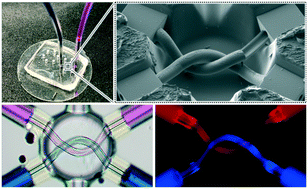3D microfluidics via cyclic olefin polymer-based in situ direct laser writing†
Abstract
In situ direct laser writing (isDLW) strategies that facilitate the printing of three-dimensional (3D) nanostructured components directly inside of, and fully sealed to, enclosed microchannels are uniquely suited for manufacturing geometrically complex microfluidic technologies. Recent efforts have demonstrated the benefits of using micromolding and bonding protocols for isDLW; however, the reliance on polydimethylsiloxane (PDMS) leads to limited fluidic sealing (e.g., operational pressures <50–75 kPa) and poor compatibility with standard organic solvent-based developers. To bypass these issues, here we explore the use of cyclic olefin polymer (COP) as an enabling microchannel material for isDLW by investigating three fundamental classes of microfluidic systems corresponding to increasing degrees of sophistication: (i) “2.5D” functionally static fluidic barriers (10–100 μm in height), which supported uncompromised structure-to-channel sealing under applied input pressures of up to 500 kPa; (ii) 3D static interwoven microvessel-inspired structures (inner diameters < 10 μm) that exhibited effective isolation of distinct fluorescently labelled microfluidic flow streams; and (iii) 3D dynamically actuated microfluidic transistors, which comprised bellowed sealing elements (wall thickness = 500 nm) that could be actively deformed via an applied gate pressure to fully obstruct source-to-drain fluid flow. In combination, these results suggest that COP-based isDLW offers a promising pathway to wide-ranging fluidic applications that demand significant architectural versatility at submicron scales with invariable sealing integrity, such as for biomimetic organ-on-a-chip systems and integrated microfluidic circuits.



 Please wait while we load your content...
Please wait while we load your content...
